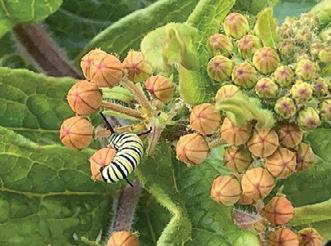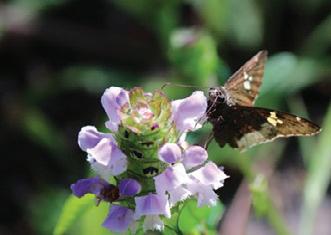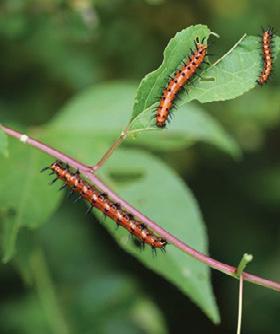
2 minute read
Planting for Pollinators
By Anna Yellin Wildlife Biologist, Conservation Section GADNR Wildlife Resources Division
A monarch caterpillar requires milkweed. In the North Georgia Piedmont, butterfly weed is one species of milkweed that occurs naturally in parts of Georgia. Photo provided by GADNR
Advertisement
Have you heard the buzz about planting for pollinators? Maintaining a garden or landscaping with native plants is an ideal way to support pollinators and other Georgia wildlife.
Although most outdoor greenery will attract some invertebrates, the plants selected will determine which you support. To help pollinators, the goal is to provide specific host plants for egg-laying, or basically plants that are required for their offspring to survive.
Insect larvae are very picky! Most will only feed on one or two species. Choosing and maintaining plants that naturally occur in your region is the key to success. Here are a few tips for getting started.
Full Sun or Partial Shade?
A shady spot may not be ideal for growing vegetables, but it will grow pollinators! A small native bush or tree that grows in partial sun can support many larvae.
For example, giant swallowtail caterpillars feed on pricklyash, and zebra swallowtail caterpillars feed on pawpaw. Native cane, a food requirement for many larvae and habitat for other invertebrates, can grow in part shade near ponds and along creeks.
Seasonal Blooming
A goal for creating pollinator spaces is to provide nectar from early spring through late autumn. Selecting plants to fill the seasons can be daunting!
Hoary edge butterfly feeding on nectar from beardtongue at Piedmont National Wildlife Refuge. Photo by Anna Yellin
Not sure where to start? Just a few passionflower vines will reward you with gulf fritillaries. Photo by Anna Yellin


Fortunately, several websites can help you with selecting plants. One is the National Wildlife Foundation’s Native Plant Finder: www.nwf.org/NativePlantFinder.
Yearlong Habitat
Pollinators love a messy garden. Some of the best resources are the naturally occurring “weeds” that aren’t pulled, the leaves not raked and the grass not mowed. Tucking themselves within these areas, invertebrates find moisture, protection from predators and insulation from inhospitable weather.
Also, on sunny porches, decks or balconies, a pot of passion flowers can grow year after year, providing food for generations of bright orange gulf fritillaries. Add a planter of native milkweed for monarchs, and you will be helping two of the butterfly species known to migrate.
Pesticide-free Care
Whether planting seeds or plants, finding the right source is essential for a successful pollinator garden. If plants have been treated to prevent insect damage, they can be deadly to pollinators.
To ensure that seeds or plants are not treated, purchase those labeled as organic or non-GMO.
Feed Pollinators, Feed the Planet
By feeding pollinators, we provide for the planet. Apart from the work pollinators do, enabling fruit to grow and seeds to form, they provide additional food benefits.
Insect larvae are packed with protein to feed newly hatched songbirds. Insects are prey for other invertebrates, small reptiles, amphibians, mammals and birds.
And at the end of the season, your plants provide meals for seedeaters that are packing on calories for migration or winter scarcity.
A praying mantis eats a meal surrounded by flowering boneset at Stone Mountain. Photo by Anna Yellin











